The St. James Building (First National Bank)
Introduction
Text-to-speech Audio
Images
The original First National Bank on 3rd Avenue

The 3rd Avenue bank during the 1913 flood
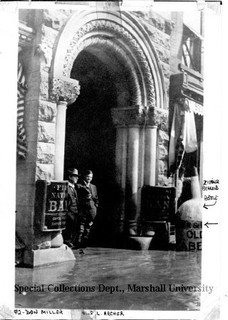
Employees at First National Bank, date unknown
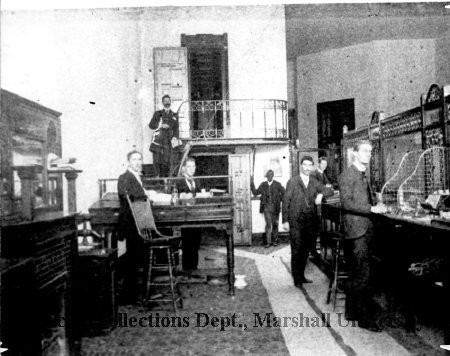
First Methodist Episcopal Church at 4th Ave & 10th St. before the bank was built
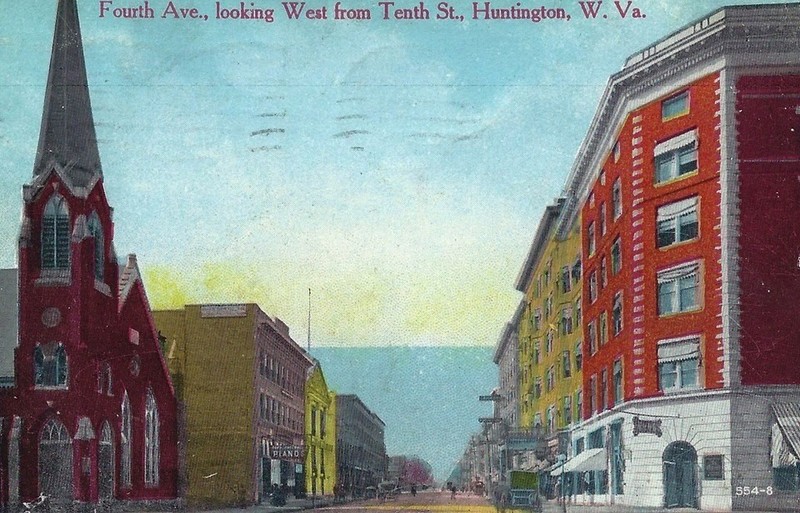
The structural steel under construction for the First Huntington National Bank circa 1913. Courtesy of Patrick Morris
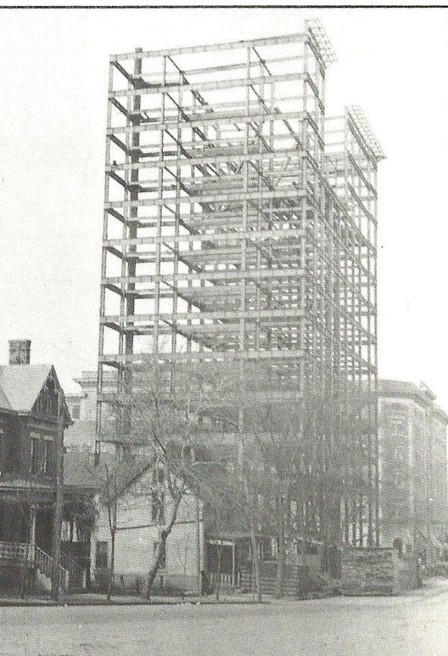
Postcard of the First National Bank, circa 1915
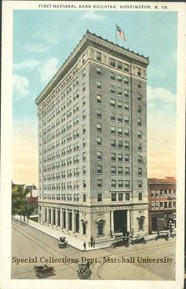
Postcard of the First National Bank, circa 1920
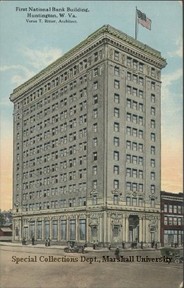
Interior of the First National Bank
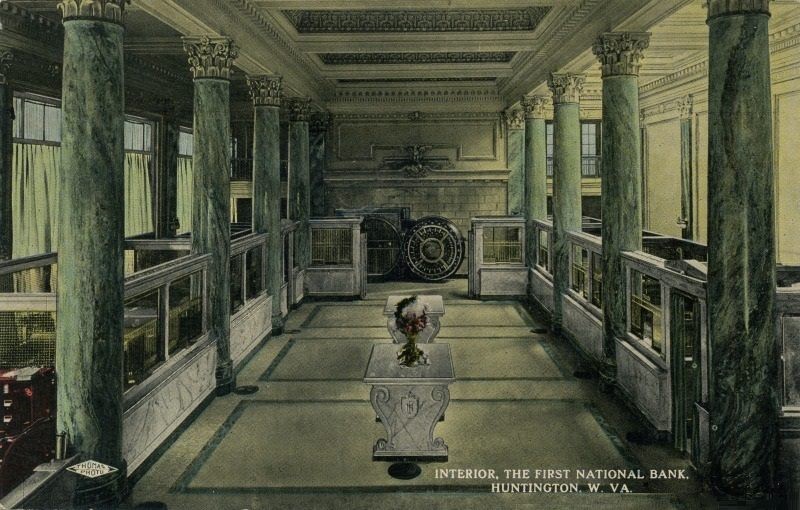
4th Ave looking west, with the bank in the background, circa 1925
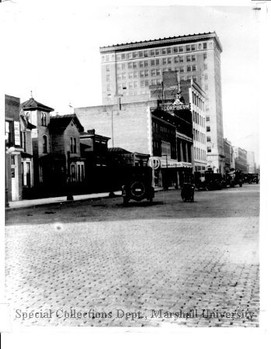
Construction of the 1925 addition
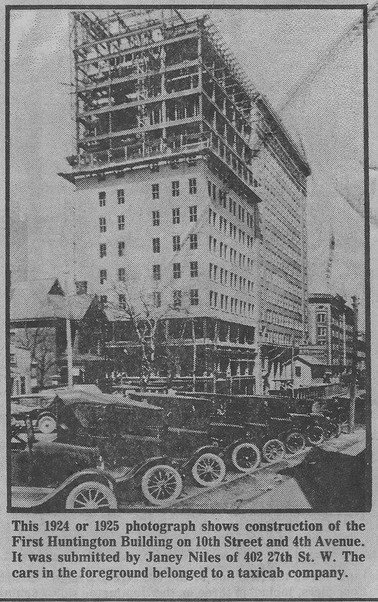
The bank during the flood of 1937
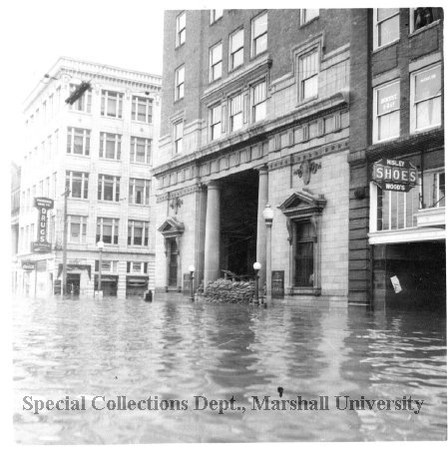
Lobby of the First National Bank Building
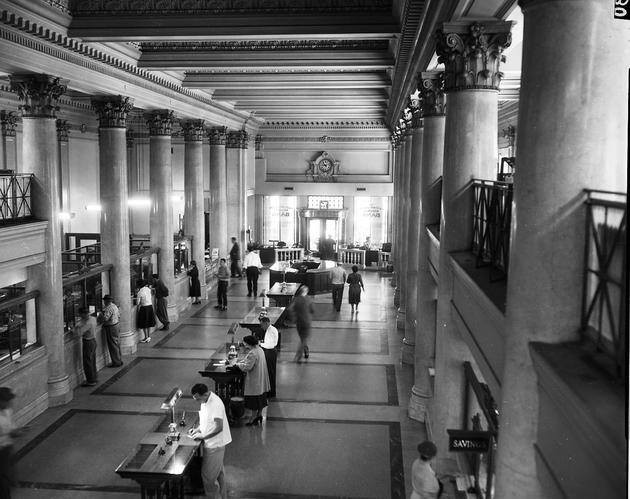
The structural steel under construction for the First Huntington National Bank circa 1913. Courtesy of Patrick Morris

First Methodist Episcopal Church at 4th Ave & 10th St. left, and Frederick Building, right, before the bank was built.

Backstory and Context
Text-to-speech Audio
When the city of Huntington was founded in 1871, enterprising businessmen soon flocked to the growing industrial and commercial center. Alongside the retailers and hotels that comprised its small downtown, it was necessary for the young city to have a bank. In 1888, the First National Bank was organized by George F. Miller, J. L. Caldwell, D. I. Smith, W. H. Hagen and other prominent businessmen. Caldwell served as its first president until his death in 1923, and Miller was executive vice president until he passed away in 1910. The bank was located in an elegant stone building at 926 3rd Avenue, which is now the site of Pullman Square. First National Bank was the second bank to open in Huntington, after the Bank of Huntington was chartered in 1875. The Bank of Huntington, which was the site of a notorious bank heist in 1875, merged with the Commercial National Bank in 1894 to form the Huntington National Bank.
As Huntington grew, becoming West Virginia’s largest city by 1910, the First National Bank prospered and soon required a larger space. In 1912, the owners of the First National Bank purchased a lot at the southwest corner of 4th Avenue and 10th Street. The lot had formerly been the site of the First Methodist Episcopal Church, which was constructed in 1875. Architect Verus T. Ritter was hired to design the new twelve-story bank building. Ritter was one of Huntington's most famous architects and had designed many other notable buildings in the city, such as the Johnson Memorial Methodist Church and Huntington City Hall. He designed the new bank in the Renaissance Revival architectural style, with an embellished first floor facade and a flat roof with decorative overhanging eaves. Upon its completion in 1914, the bank occupied the ground floor while the office spaces on the building’s upper floors were quickly rented by doctors, lawyers, and other professionals.
In 1925, the First National Bank merged with the Huntington National Bank to form the First Huntington National Bank (FHNB). With this change, the bank needed more space, prompting the construction of a twelve-story addition on the south side of the building along 10th Street. The expansion was designed and overseen by Meanor and Handloser, another prominent architectural firm in Huntington. They followed the design style of the original building so well that it was difficult to tell where the first building ended and the new section began.
In 1977, the First Huntington National Bank relocated to a new building on 5th Avenue, where it became the first bank in the area to offer 24-hour services. The Old National Bank of Huntington moved into the 4th Avenue building in 1981, before the St. James Condominium Association purchased and renamed the building six years later. The new owners paid $6.7 million for both the building and for the extensive renovations that they made. While the Old National Bank remained the ground floor tenant, the upper six floors were remodeled into luxury apartments. After the Old National Bank closed, the Fifth-Third Bank operated a branch out of the building’s ground floor from 2001 to 2011. As of 2019, the First State Bank of Barboursville occupies the first and second floors of the St. James Building. There are also a number of businesses and offices on the floors above, including the Huntington branch of the Word House Inc., McClure Goad PLLC., and Bailes, Craig & Yon PLLC. The sixth through twelfth floors hold apartments managed by the St. James Condominium Association.
Sources
Casto, James E. "Top 20 Architectural Structures." Huntington Quarterly. Huntington Quarterly.
Casto, James E. "Lost Huntington: The First National Bank." Herald-Dispatch (Huntington) January 26th 2015. https://www.herald-dispatch.com/special/lost_huntington/lost-huntington-the-first-national-bank/article_b7591ca6-0fe8-555b-937c-18d9f45ed306.html.
Dickinson, Jack L. and Alison K. Summer-Ramirez. Historic Huntington Businesses: The Birth of Huntington, W.Va. 1871-1900. Huntington, WV: Marshall University Libraries, 2016.
St. James Condominium Association. Facebook. https://www.facebook.com/St-James-Condominiums-Huntington-WV-487147214727668/?hc_ref=SEARCH&fref=nf.
https://marshall.pastperfectonline.com/photo/70B7A25F-408E-447B-AF0D-224122042300
https://marshall.pastperfectonline.com/photo/7B9E3568-BE45-4431-8896-134105054293
https://marshall.pastperfectonline.com/photo/70CE8F4A-8A05-467C-8C09-549411016841
https://marshall.pastperfectonline.com/photo/261724BB-9287-45EF-B078-143486522740
https://marshall.pastperfectonline.com/photo/ADA70854-6205-4D13-9687-197569761238
https://www.facebook.com/photo.php?fbid=1845138762192975&set=gm.1963439990546741&type=3&theater&ifg=1
https://marshall.pastperfectonline.com/photo/F98562EB-D813-4661-8836-716877072636
https://www.facebook.com/photo.php?fbid=1296299627076894&set=p.1296299627076894&type=3&theater
https://marshall.pastperfectonline.com/photo/65F3B18B-D92B-40FC-B6C0-406902950020
https://www.facebook.com/photo.php?fbid=998412353532291&set=gm.1650158531874890&type=3&theater&ifg=1
